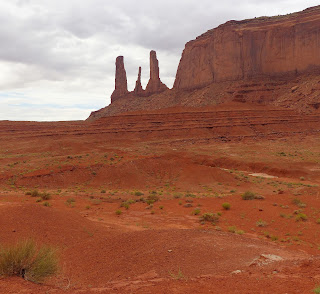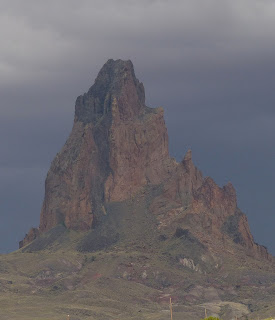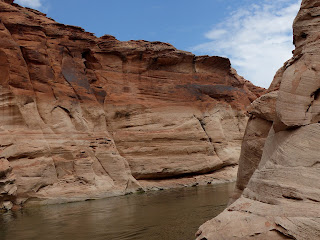One of the unique aspects of Santa Fe is its appearance. A building code was passed in 1912 requiring that all buildings within the downtown area be built in a Spanish style, basically adobe. There are still some truly old adobe buildings downtown, but most have been built more recently. Still, it gives the town a "different" look. They like to be known as "different". The other thing about Santa Fe is the beautiful location in a valley, surrounded by mountains.
Santa Fe just has a certain "feel"- friendly, comfortable, a place you could come back to many times and find something to do. There are nearby ski areas for winter enthusiasts, lots of art, and LOTS of shopping. The restaurants are numerous, as well.
After our tour, Dale and I visited several of the sites pointed out to us by our tour guide. The Loretto chapel on the Old Santa Fe Trail is known for its "Miraculous Staircase". The story goes that the nuns of the chapel prayed to St. Joseph, the patron saint of carpenters, for help with a way to access the second story of the chapel, as it had been built too narrow for a normal stairway. A few days later, a stranger showed up, built a spiral staircase using wooden pegs for support, then disappeared. There is still a debate among builders and engineers on how the staircase is actually supported.
The Cathedral Basilical of Saint Francis was built in a Romanesques style, very different than the surrounding buildings. The building never got the steeples it was supposed to have, as they ran out of money to complete them- even after having borrowed from the local Jewish synagogue! Still very pretty chapel with a nice statue of St. Francis out front.
The rest of the day was spent at lunch and investigating one of the oldest houses in the U.S.- not really very impressive. The lunch, however, was great! We decided to stay an additional night in Santa Fe in order to go up to Taos the next day.
Saturday morning we headed up to Taos, about an hour and a half from Santa Fe. Somehow, I thought Taos was more up in the mountains than Santa Fe, but it is really at the same elevation. There is a well-known ski area here, so winter sports are abundant. The drive up to Taos was really nice. There were some winding mountain roads, the main road going through many small towns. As we were driving, we noticed a large river coming down the mountains and wondered what it was. We also noticed several pull-out areas for rafts to be put in the river. There was a Visitor Center near one of these, so we pulled in. We were very surprised to find out that the whole area was the Rio Grande Gorge National Monument.
The Rio Grande River starts in the San Juan Mountains of Colorado, and comes down into Mexico, than empties into the Gulf of Mexico after creating part of the border between Texas and Mexico. The river here, designated as a National Wild and Scenic River, is wide and full of rapids. The Monument, which was designated on March 25, 2013 by President Obama, encompasses 242,455 acres and is, again, managed by the the BLM. We spent some time in the Visitor Center talking with the docent and looking at maps. Just never know what you will find in your travels....
The docent directed us in how to find the deepest part of the Rio Grande Gorge. Just north of Taos, Rt. 64 crosses the gorge on a bridge. We found the spot and spent a few minutes taking photos before heading back into town. The gorge is pretty impressive, much newer geologically than the Grand Canyon, having been cut into the thin crust of the volcanically- active area.
Taos is quite a bit smaller than Santa Fe. I had expected that I would like it better than Santa Fe, but did not. The plaza was nice, we strolled around town looking at some of the shops and galleries, but it just did not have the same feel for me. However, the surrounding area is beautiful- a large, grassy valley surrounded by mountains with this clear, clean air.
This whole area is just very special, and is certainly a spot that you could revisit easily and find lots to do. Keep it on your list!






















































